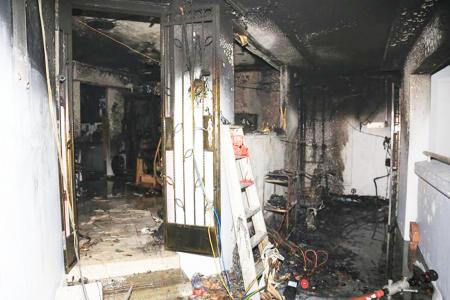More fires caused by Personal Mobility Device batteries
Some users now conscious of how they charge personal mobility devices and mobile phones
When his e-scooter battery exploded, Mr Shah Rizal Abdul Razak was in the same room and had little time to react.
Within seconds, it was engulfed in flames.
The 34-year-old civil servant had time only to get out of the four-room HDB flat in Woodlands before the fire spread to the rest of the house.
When the fire was finally put out by the Singapore Civil Defence Force (SCDF), he found that his furniture was destroyed, and the walls and ceiling were blackened.
All sparked by an e-scooter he paid $1,200 for.
The incident on Sept 22 taught him an important lesson.
"Now, I won't charge if I'm not going to be around, and I will not leave anything to charge overnight," he said.
He is also unlikely to make use of such personal mobility devices again unless a more stable battery is introduced.
Fires caused by batteries, such as in Mr Rizal's case, have been on the rise despite an overall drop in total number of fires. There have been 13 such fires this year, up from the eight last year.
Mr Tommy Tsang, 51, a broadcast engineer, said he makes sure to buy only chargers and devices that are safe. He said that while they may cost more, the safety and peace of mind they give him make a higher price tag more than worth it.
He always checks the safety features and prefers devices that have a cut-off function when fully charged.
Plus, the e-bike rider said he charges his e-bike outside his home and ensures that the chargers and batteries are well ventilated and kept cool.
He also checks to ensure that the wires are insulated and there is no rain or block-washing occurring while he charges his e-bike.
Beyond personal mobility devices, people are also more careful with how they charge their phones and laptops too.
NOT BROKEN
Ms Mervelle Lek, 23, a fresh graduate, said she ensures that charging cables are not broken and the wires are not exposed.
She also takes care with where she leaves the device to charge, avoiding materials or surfaces that could cause it to overheat, such as beds or carpets.
Associate Professor Soh Chew Beng, deputy programme director of electrical power engineering at Singapore Institute of Technology, said battery fires are often caused by two basic types of failures.
One is a predictable failure, where there is a design flaw that leads to overheating to the point where the shell is unable to contain the spontaneous reaction.
The second is more random - there is no obvious design flaw, but a possible stress event happens during charging or due to vibration generated at the source.
Prof Soh said fires can be prevented. If a battery overheats, hisses or bulges, immediately move the device away from flammable materials and place it on a non-combustible surface away from electrical supply.
If at all possible, remove the battery and put it outdoors to burn out.
He said while batteries are generally safe, buying from quality-controlled, reputable brands will help.
SCDF's battery fire advisory recommends that users avoid overcharging the battery, especially leaving it to charge overnight.
Some models do not have a power cut-off function to prevent overcharging, which could lead to sparking off a fire. Such fires have the propensity to spread easily, particularly when there are combustible materials around, said the SCDF.
FOR MORE, READ THE STRAITS TIMES TODAY
Get The New Paper on your phone with the free TNP app. Download from the Apple App Store or Google Play Store now



